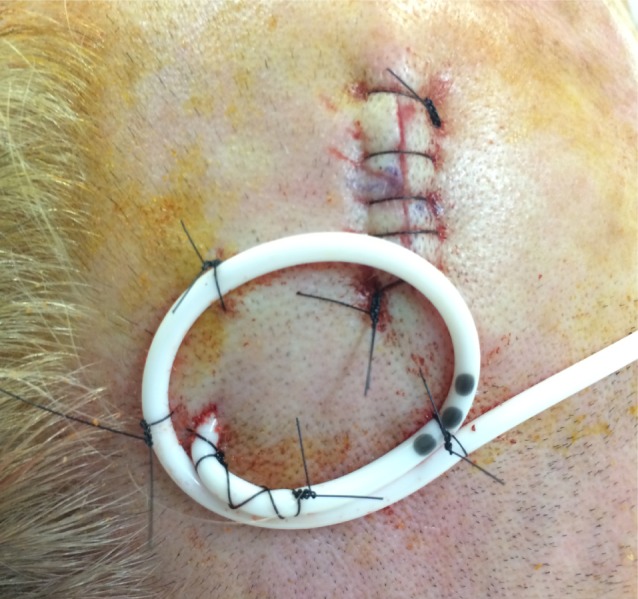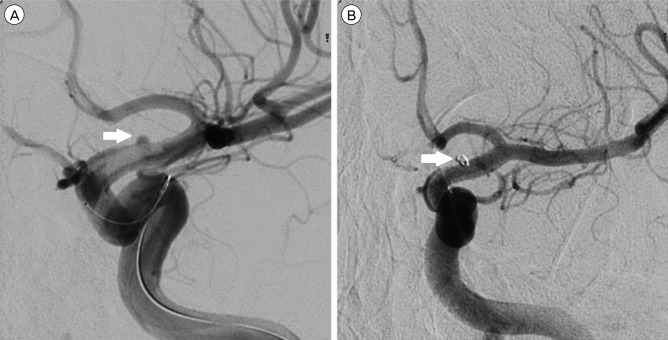J Cerebrovasc Endovasc Neurosurg.
2015 Mar;17(1):54-58. 10.7461/jcen.2015.17.1.54.
Ventriculoperitoneal Shunt in a Patient with Ruptured Blister Aneurysm Treated with Pipeline Embolization Device
- Affiliations
-
- 1Department of Neurosurgery, Rush University Medical Center, Chicago, IL, United States. Lee_tan@rush.edu
- KMID: 1963151
- DOI: http://doi.org/10.7461/jcen.2015.17.1.54
Abstract
- Cerebral spinal fluid (CSF) diversion is frequently required in patients with aneurysmal subarachnoid hemorrhage who develop subsequent hydrocephalus. Procedures such as external ventricular drain (EVD) and ventriculoperitoneal shunt (VPS) usually carry a very low rate of complications. However, as flow diverting stents such as Pipeline Embolization Device (PED) become more widely available, flow diverters are being used in treatment of some ruptured complex aneurysms. EVD and VPS placement in the setting of dual antiplatelet therapy (DAT) in these patients are associated with a significant risk of intracranial hemorrhage. We describe a management strategy and surgical technique that can minimize hemorrhagic complications associated with VPS in patients on DAT after treatment with flow diverting stents.
MeSH Terms
Figure
Reference
-
1. Kung DK, Policeni BA, Capuano AW, Rossen JD, Jabbour PM, Torner JC, et al. Risk of ventriculostomy-related hemorrhage in patients with acutely ruptured aneurysms treated using stent-assisted coiling. J Neurosurg. 2011; 4. 114(4):1021–1027. PMID: 20950080.
Article2. Lin N, Brouillard AM, Keigher KM, Lopes DK, Binning MJ, Liebman KM, et al. Utilization of Pipeline embolization device for treatment of ruptured intracranial aneurysms: US multicenter experience. J Neurointerventional Surg. 2014; 9. pii: neurintsurg-2014-011320. 10.1136/neurintsurg-2014-011320.
Article3. Mahaney KB, Chalouhi N, Viljoen S, Smietana J, Kung DK, Jabbour P, et al. Risk of hemorrhagic complication associated with ventriculoperitoneal shunt placement in aneurysmal subarachnoid hemorrhage patients on dual antiplatelet therapy. J Neurosurg. 2013; 10. 119(4):937–942. PMID: 23808537.
Article4. Munich SA, Tan LA, Keigher KM, Chen M, Moftakhar R, Lopes DK. The Pipeline Embolization Device for the treatment of posterior circulation fusiform aneurysms: lessons learned at a single institution. J Neurosurg. 2014; 11. 121(5):1077–1084. PMID: 25192476.
Article5. Parker SL, Anderson WN, Lilienfeld S, Megerian JT, McGirt MJ. Cerebrospinal shunt infection in patients receiving antibiotic-impregnated versus standard shunts. J Neurosurg Pediatr. 2011; 9. 8(3):259–265. PMID: 21882917.6. Sweeney JM, Vasan R, van Loveren HR, Youssef AS, Agazzi S. Catheter fixation and ligation: a simple technique for ventriculostomy management following endovascular stenting. J Neurosurg. 2013; 5. 118(5):1009–1013. PMID: 23472845.
Article7. Tan LA, Moftakhar R, Lopes DK. Treatment of a ruptured vertebrobasilar fusiform aneurysm using pipeline embolization device. J Cerebrovasc Endovasc Neurosurg. 2013; 5. 15(1):30–33. PMID: 23593603.
Article8. Tumialán LM, Zhang YJ, Cawley CM, Dion JE, Tong FC, Barrow DL. Intracranial hemorrhage associated with stent-assisted coil embolization of cerebral aneurysms: a cautionary report. J Neurosurg. 2008; 6. 108(6):1122–1129. PMID: 18518714.
Article9. Yoon JW, Siddiqui AH, Dumont TM, Levy EI, Hopkins LN, Lanzino G, et al. Feasibility and safety of pipeline embolization device in patients with ruptured carotid blister aneurysms. Neurosurgery. 2014; 10. 75(4):419–429. PMID: 24991709.
- Full Text Links
- Actions
-
Cited
- CITED
-
- Close
- Share
- Similar articles
-
- A Case of Ruptured Blood Blister-like Aneurysm Treated with Pipeline Embolization Device: Clinical Significance of Fetal-type Posterior Communicating Artery
- Treatment of a Ruptured Vertebrobasilar Fusiform Aneurysm Using Pipeline Embolization Device
- The Use of a Pipeline Embolization Device for Treatment of a Ruptured Dissecting Middle Cerebral Artery M3/M4 Aneurysm: Challenges and Technical Considerations
- Electrothermal Coil Detachment Failure in Flow Diverter-Assisted Coiling of a Small Blister Aneurysm: Technical Considerations and Possible Solutions
- Persistent Aneurysm Growth Following Pipeline Embolization Device Assisted Coiling of a Fusiform Vertebral Artery Aneurysm: A Word of Caution!





